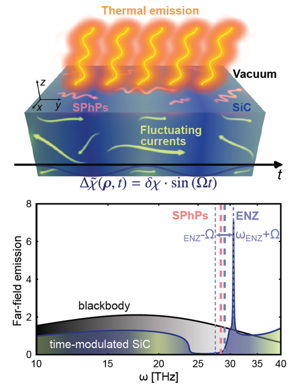 [Enlarge image]Top: Conceptual illustration of the thermal radiation emanating from a time-modulated planar slab. Bottom: Emission spectrum of SiC under a time-harmonic modulation at frequency Ω.
[Enlarge image]Top: Conceptual illustration of the thermal radiation emanating from a time-modulated planar slab. Bottom: Emission spectrum of SiC under a time-harmonic modulation at frequency Ω.
Incandescence is a universal phenomenon whereby any body at finite temperature emits electromagnetic radiation. Unlike the light emanating from coherent sources, thermal radiation is ubiquitous and inherently incoherent, which translates into broadband, omnidirectional and unpolarized emission.1 These radiation features are condensed within Planck’s law, under which the emission spectrum of a blackbody at thermal equilibrium depends solely on its temperature.
Beyond this ideal scenario, Kirchhoff’s radiation law and the formalism of fluctuational electrodynamics have enabled a comprehensive pathway for analyzing and tuning the emission spectra of realistic systems. They have also granted access to near-field effects and, ultimately, established the blackbody spectrum as a fundamental physical limit. Together with the latest breakthroughs carried out in nanophotonics and materials science, this has laid down the basis of thermal-emission engineering, showcasing the outstanding potential of photonic nanostructures to control thermal radiation.1
Following the ongoing parallel paths of nanophotonics and thermal engineering, and motivated by the recent upsurge of interest in temporal metamaterials, or time-varying media,2 we have recently elaborated a theoretical framework, based on macroscopic quantum electrodynamics, to address incandescence in time-modulated media.3 Merely by generalizing the fluctuation-dissipation theorem to time-varying media, we unveiled unique physical features such as the existence of nonlocal correlations in space and frequency. We also surfaced the possibility of modifying the photon distribution, and hence tuning and enhancing the radiation even beyond the blackbody spectrum, as well as the existence of vacuum amplification effects at finite temperatures.
We investigated these effects using the model of a time-harmonically modulated planar slab made of silicon carbide.3 In the model, due to the temporal modulation, the far-field emission spectrum exhibited a sharp peak exceeding the blackbody, thus producing super-Planckian emission. Interestingly, such a release, actually attributed to the dynamical amplification of quantum vacuum and persistent at all regimes, occurs at the material’s epsilon-near-zero (ENZ) frequency, where the vacuum fluctuations become enormously strong but remain trapped in the absence of modulation. We also recently demonstrated that temporally shaping the quantum vacuum enables control on the generation of squeezed states of light,4 high-fidelity quantum state frequency shifting, and ultrafast material switching without noise amplification.5
In our view, the mere addition of time as a degree of freedom has extraordinary implications that could shake up some major principles of physics. We expect that our findings will stimulate the search for additional phenomena, potential applications and feasible approaches for their realization.
Researchers
J.E. Vázquez-Lozano and I. Liberal, Universidad Pública de Navarra, Spain
References
1. D.G. Baranov et al. Nat. Mater. 18, 920 (2019).
2. E. Galiffi et al. Adv. Photon. 4, 014002 (2022).
3. J.E. Vázquez-Lozano and I. Liberal. Nat. Commun. 14, 4606 (2023).
4. J.E. Vázquez-Lozano and I. Liberal. Nanophotonics 12, 539 (2023).
5. I. Liberal et al. Laser Photon. Rev. 17, 2200720 (2023).
